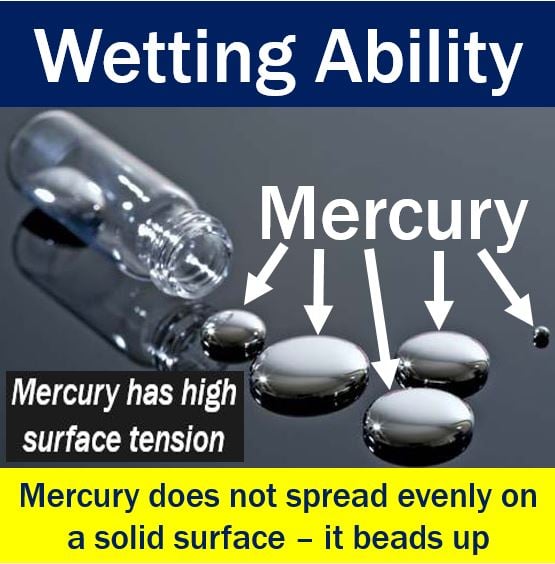Wetting ability is a liquid’s ability to maintain contact with another surface, to spread easily and uniformly over the surface of another solid or fluid. A liquid with high wetting ability forms a thin, continuous film when it spreads over the surface of something.
A liquid’s wettability – its degree of wetting – is determined by a force balance between cohesive and adhesive forces.
At the point in which the fluid touches the surface of a solid – the liquid-solid surface interface – if the fluid’s molecules have a stronger attraction to the molecules of the solid surface than to each other – the adhesive forces are greater than the cohesive forces – wetting of the surface occurs.
On the other hand, if the fluid molecules are more strongly attracted to each other than the solid surface’s molecules – the cohesive forces are greater than the adhesive forces – the liquid does not spread uniformly across the surface; instead it beads up.

A fluid with a high surface tension, such as mercury, has very little or no wetting ability. Petroleum, solvents, and other liquids with a low surface tension have a high wetting ability.
Water has medium surface tension. Water’s wetting ability increases if you add a wetting agent to it.
A fluid’s wetting ability is of crucial importance in several industries, including printing, painting, dyeing, and cleaning.
According to The Law Dictionary, wetting ability is the “ability of a fluid to spread uniformly over the surface of another or a sold, and form a thin continuous film.”
Wetting ability – wetting agents
Wetting agents are substances that reduce a liquid’s – for example, water’s – surface tension, and allow it to spread evenly across a surface, thus increasing its wetting ability.
Reducing the surface tension lowers the amount of energy required to spread drops onto a surface, thus weakening the liquid’s cohesive properties and enhancing its adhesive properties.
Dish soap (British: washing up liquid) is a good example of a wetting agent. With all the food oils on the surface of a dish, cohesive forces make it hard for the water to spread and clean the dish.
The dish soap dissolves these unwanted particles, leaving a clean surface exposed. The soap also reduces water’s surface tension, giving it greater wetting ability, i.e. making it spread more evenly across the entire surface.
Regarding how you can tell whether a liquid contains a wetting agent, Chem.LibreTexts.org writes:
“One method of knowing whether or not a liquid has a wetting agent in it is to spread the liquid on a surface that is coated in grease. If the liquid does not contain a wetting agent, then its cohesive forces would overpower adhesive forces, causing the liquid to form droplets on the surface.”
“If the liquid does contain a wetting agent, the grease would be dissolved and the surface tension of the liquid would be lowered, causing the adhesive forces to overpower the cohesive forces. This would result in the liquid spreading evenly along the surface.”
Video – Surface tension and adhesion
This Khan Academy Medicine video explains the concepts of surface tension, cohesion, and adhesion.
Rather than looking at water when it is placed on top of another surface, it shows you what happens when you place a needle on the surface of the water.
Wetting ability is directly related to a fluid’s surface tension, cohesion, and adhesion.
